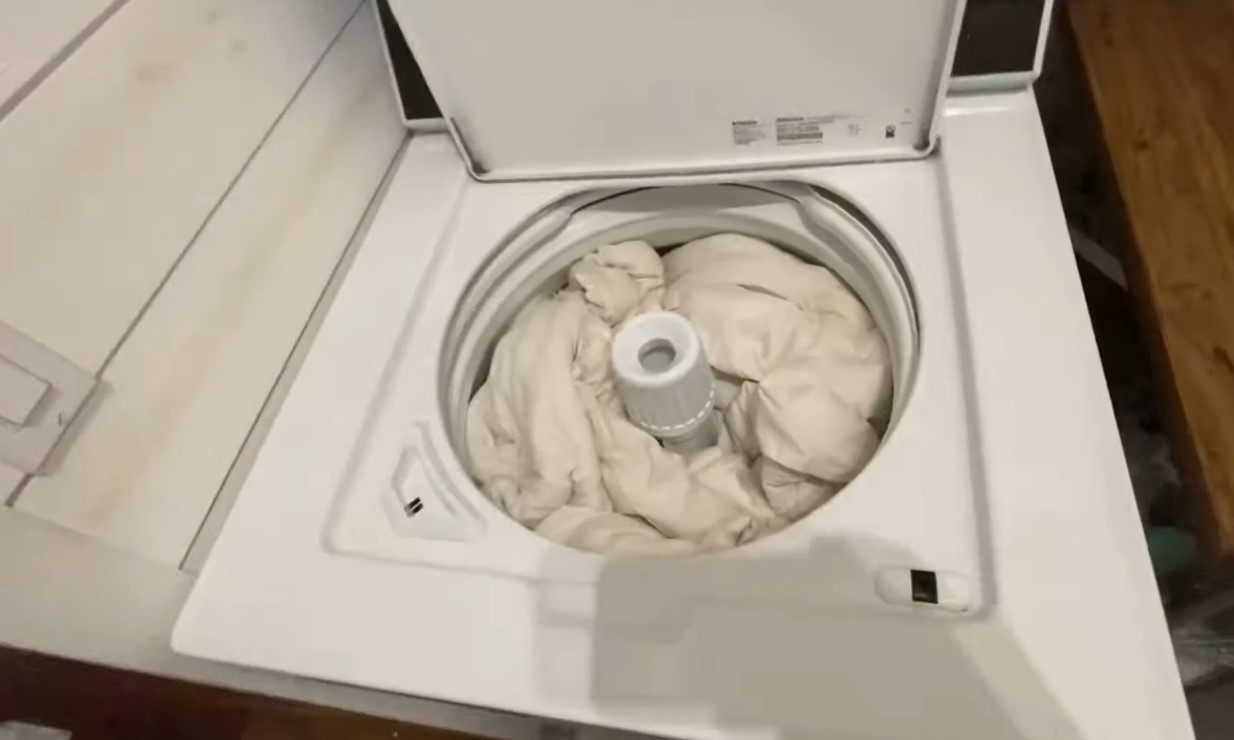Home>Furniture>Bedroom Furniture>How To Wash A Bed Comforter


Bedroom Furniture
How To Wash A Bed Comforter
Modified: August 27, 2024
Learn the best method to wash your bed comforter and keep your bedroom furniture fresh and clean. Follow our step-by-step guide for effective results.
(Many of the links in this article redirect to a specific reviewed product. Your purchase of these products through affiliate links helps to generate commission for Storables.com, at no extra cost. Learn more)
Introduction
Welcome to our comprehensive guide on how to properly wash a bed comforter. Your bed comforter is an essential and cozy part of your bedroom, providing warmth and comfort throughout the year. However, over time, it can accumulate dirt, stains, and allergens that need to be addressed for the sake of both cleanliness and hygiene.
Washing a bed comforter might seem like a daunting task, but with the right knowledge and approach, it can be a relatively simple process. In this article, we will provide you with step-by-step instructions on how to wash your comforter effectively, ensuring that it remains clean, fresh, and comfortable.
Before we dive into the washing process, it’s important to emphasize that not all comforters are created equal. Different comforters come with different care instructions, and it’s crucial to pay attention to these details to avoid damaging the fabric or losing color vibrancy. Taking the time to understand the specific care requirements for your comforter will help ensure the longevity of its quality and appearance.
In the following sections, we will provide you with the necessary guidance to tackle common challenges related to washing your bed comforter. This includes spot treating stains, selecting the appropriate washing method, and drying the comforter properly to maintain its shape and fluffiness.
By following our expert tips and advice, you will be able to keep your bed comforter clean, fresh, and inviting for a luxurious night’s sleep. So let’s get started on the journey to a cleaner and more comfortable bedroom!
Key Takeaways:
- Properly preparing your comforter for washing, spot treating stains, and selecting the appropriate washing and drying methods are crucial for maintaining its cleanliness and longevity.
- Regularly fluffing, using a duvet cover, and following care instructions will help extend the lifespan of your comforter, keeping it fresh and cozy for years to come.
Preparing the Comforter for Washing
Before you begin washing your bed comforter, it’s important to properly prepare it to ensure the best cleaning results. Here are some essential steps to follow:
- Remove any decorative elements: Check your comforter for any decorative elements such as buttons, sequins, or beads, and remove them if possible. These embellishments can get damaged or cause damage to your washing machine, so it’s best to remove them beforehand. If you can’t remove them, place the comforter in a duvet cover to protect them during the washing process.
- Check for tears or loose seams: Inspect the comforter for any tears or loose seams. If you find any, mend them using a needle and thread before washing. This will prevent further damage during the washing and drying process.
- Shake it out: Take the comforter outside if possible and give it a good shake to remove any loose dirt or debris. This step helps to minimize the amount of dirt that ends up in your washing machine.
- Pre-treat stains: If you notice any stains on your comforter, it’s best to pre-treat them before washing. Use a stain remover or a mixture of water and mild detergent to gently rub the stained areas. Let it sit for a few minutes before proceeding to the washing step.
- Choose the right detergent: It’s crucial to select the appropriate detergent for washing your comforter. Avoid using harsh chemicals or bleach, as they can damage the fabric and affect its color. Instead, opt for a mild detergent specifically formulated for delicate fabrics.
By taking the time to properly prepare your comforter for washing, you will ensure that it is ready to undergo the cleaning process effectively. This will help maintain the quality and appearance of your comforter, keeping it fresh and inviting for years to come.
Checking the Care Instructions
Before proceeding with washing your bed comforter, it’s crucial to thoroughly check the care instructions provided by the manufacturer. These instructions can typically be found on a label attached to the comforter. Care instructions will vary depending on the material, size, and construction of the comforter.
Here are some key points to consider when checking the care instructions:
- Machine wash vs. hand wash: The care instructions will specify whether the comforter is suitable for machine washing or if it requires hand washing. It is important to adhere to these instructions to avoid damaging the fabric or altering its appearance.
- Water temperature: The care instructions will indicate the recommended water temperature for washing the comforter. Some comforters may require cold or warm water, while others may be safe to use hot water. Following the specified temperature will ensure effective cleaning without causing any harm to the comforter.
- Drying instructions: The care instructions will also provide guidance on the recommended drying method for the comforter. It may specify whether it can be tumble dried, line dried, or if it needs to be air dried. This information is essential to prevent shrinking, distortion, or damage to the fabric.
- Additional care tips: The care instructions may include additional tips or precautions specific to the comforter. This could include avoiding the use of certain cleaning products, using a specific type of detergent, or avoiding exposure to direct sunlight during drying.
By carefully reviewing and following the care instructions, you can ensure that you are treating your comforter properly. This will help maintain its quality, color, and overall appearance, ultimately prolonging its lifespan and ensuring years of cozy sleep.
Spot Treating Stains
Stains are a common occurrence on bed comforters, whether it’s from food spills, body oils, or other accidents. Before washing the entire comforter, it’s important to spot treat any stains to maximize the chances of removal. Here’s how you can effectively spot treat stains on your comforter:
- Identify the type of stain: Different types of stains require different treatment approaches. Common types include food stains, sweat stains, and oil-based stains. Identify the stain so you can choose the appropriate stain removal method.
- Pre-treat the stain: Before washing, pre-treat the stain by applying a small amount of stain remover directly to the stained area. Gently rub the stain remover into the fabric using a clean cloth or sponge. Allow it to penetrate the stain for a few minutes before proceeding to the next step.
- Blot the stain: After pre-treating, blot the stain with a clean, damp cloth. Do not rub the stain, as this can spread it further into the fabric. Instead, gently blot the area to lift the stain. Repeat this process until the stain begins to fade.
- Wash the comforter: Once you’ve spot treated the stain, it’s time to proceed with washing the entire comforter. Follow the care instructions mentioned earlier in this guide to determine the appropriate washing method and water temperature.
- Inspect the stain after washing: After washing, inspect the stained area. If there are any remnants of the stain, repeat the spot treatment process before drying the comforter.
It’s important to note that not all stains can be completely removed, especially if they are old or deeply set. Patience and persistence are key when dealing with stubborn stains. If you’re unsure about the best spot treatment method for a specific type of stain or fabric, consult a professional cleaner for advice.
By spot treating stains before washing, you increase the chances of completely removing them and restoring the appearance of your comforter. This will help maintain its overall cleanliness and freshness, allowing you to enjoy a cozy and inviting sleep environment.
Selecting the Appropriate Washing Method
When it comes to washing your bed comforter, selecting the appropriate washing method is key to ensuring its cleanliness and longevity. The washing method you choose will depend on factors such as the size of your comforter, the material it’s made of, and the care instructions provided by the manufacturer. Here are some common washing methods for different types of comforters:
- Machine washing: Many comforters can be safely washed in a washing machine, making it a convenient option. However, it’s important to consider the capacity of your washing machine to ensure that the comforter has enough space to move freely. Use a gentle or delicate cycle to minimize damage to the fabric.
- Hand washing: For delicate or oversized comforters that may not fit in a standard washing machine, hand washing is an alternative option. Fill a bathtub or large basin with lukewarm water and a mild detergent. Gently agitate the comforter in the water for a few minutes, paying special attention to stained or soiled areas.
- Professional cleaning: If your comforter is made of delicate or high-maintenance material, it may require professional cleaning. Take your comforter to a reputable dry cleaner experienced in handling bedding items. They will have the expertise to clean and maintain the quality of your comforter.
Regardless of the washing method you choose, it’s important to follow these tips:
- Use a gentle detergent: Opt for a mild detergent specifically designed for delicate fabrics. Harsh detergents can damage the fabric and cause color fading.
- Avoid overloading: Whether using a washing machine or hand washing, avoid overloading the comforter. This ensures that the detergent and water can circulate freely, providing a thorough cleaning.
- Follow the recommended water temperature: Adhere to the water temperature specified in the care instructions. Hot water can shrink or damage certain fabrics, while cold water may not effectively remove stains or dirt.
By selecting the appropriate washing method and following these tips, you’ll be able to effectively clean your bed comforter without compromising its quality and appearance.
To wash a bed comforter, use a large capacity washing machine and mild detergent. Add a few tennis balls to help fluff the comforter. Air dry or use a large dryer on low heat.
Read more: How To Make Your Bed More Comfortable
Using a Washing Machine
Washing your bed comforter in a washing machine is a convenient and efficient method, provided that it is suitable for machine washing according to the care instructions. Here are the steps to follow when using a washing machine:
- Check the machine’s capacity: Before loading the comforter into the machine, make sure it can accommodate the size and weight of the comforter. It’s important to allow enough space for the comforter to move freely during the wash cycle.
- Pre-treat stains: If you haven’t already spot treated any stains, it’s a good idea to do so before placing the comforter in the washing machine. This will help ensure that the stains have a better chance of being completely removed.
- Select a gentle cycle: Choose a gentle or delicate cycle on your washing machine. This cycle is typically designed to provide a gentle washing action, minimizing the risk of fabric damage or tangling.
- Add mild detergent: Add a mild detergent specifically formulated for delicate fabrics to the washing machine. Follow the detergent manufacturer’s instructions for the recommended amount based on the load size.
- Start the wash cycle: Start the washing machine and allow it to complete the cycle. Avoid using hot water unless specified in the care instructions, as it can potentially damage the comforter’s fabric.
- Perform an extra rinse: After the main wash cycle is complete, consider running an additional rinse cycle to ensure that all detergent residue is thoroughly removed from the comforter.
- Drying the comforter: Once the washing is complete, it’s time to dry the comforter properly. Refer to the care instructions to determine the appropriate drying method.
It’s worth noting that some comforters may be too large to fit comfortably in a standard household washing machine. In such cases, consider using a commercial-sized machine at a laundromat or opting for a professional cleaning service to ensure a thorough and proper cleaning.
By following these steps and using a suitable washing machine, you can effectively clean your bed comforter, leaving it fresh, clean, and ready for a cozy night’s sleep.
Hand-Washing the Comforter
If your bed comforter is delicate, oversized, or made of a material that is not suitable for machine washing, hand-washing is a gentle and effective method. Here’s how you can hand-wash your comforter:
- Prepare a washing solution: Fill a bathtub or a large basin with lukewarm water. Add a mild detergent specifically designed for delicate fabrics and mix it well to create a soapy solution.
- Immerse the comforter: Submerge the comforter into the soapy water and gently agitate it. Ensure that the comforter is evenly saturated with the washing solution for thorough cleaning.
- Gently clean the comforter: Using your hands, softly rub the comforter in a circular motion to clean the fabric. Focus on stained or soiled areas, but be gentle to avoid pulling or damaging the fabric.
- Rinse the comforter: Drain the soapy water and refill the basin or bathtub with clean, lukewarm water. Rinse the comforter by submerging it and gently squeezing out any excess soap.
- Repeat the rinse: If needed, repeat the rinsing process until the water runs clear, indicating that all soap residue has been removed.
- Remove excess water: Gently squeeze the comforter to remove excess water, taking care not to twist or wring it, as this can cause the fabric to stretch or become misshapen.
- Drying the comforter: Refer to the care instructions to determine the appropriate drying method for your comforter.
When hand-washing your comforter, it’s important to be patient and gentle to avoid damaging the fabric. Take your time to ensure that all areas of the comforter are thoroughly cleaned and rinsed.
If you have limited space for drying or find it difficult to handle the wet comforter, consider using a large-capacity dryer on a low heat setting or hang the comforter outside on a clothesline to air dry, ensuring that it is fully supported and not stretched.
By following these steps and hand-washing your comforter with care, you can effectively clean it while preserving its quality and integrity.
Drying the Comforter
After washing your bed comforter, the drying process is essential to ensure that it retains its shape and fluffiness. The appropriate drying method may vary depending on the comforter’s material and care instructions. Here are some common drying methods to consider:
- Tumble drying: If the care instructions allow for it, placing the comforter in a large-capacity dryer on a low heat or delicate setting is a convenient option. Add a couple of clean tennis balls or dryer balls to help fluff the comforter and prevent clumping.
- Line drying: If weather permits, hanging the comforter on a clothesline to air dry is an excellent natural option. Ensure that the comforter is evenly spread out to maintain its shape. It’s also advisable to flip it occasionally to ensure even drying.
- Air drying: If you don’t have access to a dryer or prefer not to use one, air drying is an alternative method. Lay the comforter flat on a clean, dry surface, such as a clean bedsheet or a large towel. Flip it occasionally to promote even drying.
- Professional drying: For delicate or high-maintenance comforters, it’s best to consult the care instructions or seek professional cleaning. A professional cleaner will have the equipment and expertise to properly dry your comforter while preserving its quality.
Regardless of the drying method you choose, it’s important to ensure that the comforter is fully dry before storing or using it again. A damp or moist comforter can develop a musty odor or even lead to the growth of mold or mildew.
It’s also important to avoid exposing the comforter to direct sunlight during the drying process, as this can cause fading and damage to certain fabrics. If you’re line drying, choose a shaded area or hang the comforter indoors away from direct sunlight.
Remember, the drying process may take several hours or even a full day, depending on the size and thickness of the comforter. Be patient and allow adequate time for the comforter to dry completely.
By following the appropriate drying method and ensuring that the comforter is thoroughly dry, you can maintain its fluffiness, shape, and overall freshness.
Tips for Maintaining and Storing the Comforter
To prolong the life and quality of your bed comforter, it’s important to follow proper maintenance and storage practices. Here are some helpful tips to keep in mind:
- Regularly fluff and shake: To maintain the fluffiness and loft of your comforter, give it a good shake and fluff it up regularly. This helps redistribute the filling and prevent it from becoming flat or clumped in certain areas.
- Use a duvet cover: Consider using a duvet cover to protect your comforter from stains, spills, and general wear and tear. A duvet cover is easier to wash and can be changed more frequently than the comforter itself.
- Rotate your comforter: To ensure even wear, rotate and flip your comforter regularly. This helps prevent certain areas from becoming compressed or worn out faster than others.
- Avoid sitting or stepping on it: Discourage sitting or stepping on your comforter, as this can cause damage to the filling and fabric. Treat your comforter with care to maintain its integrity.
- Store in a breathable bag or container: When not in use, store your clean and thoroughly dried comforter in a breathable bag or container. Avoid using plastic bags, as they can trap moisture and lead to musty odors or mold growth. Instead, opt for a fabric storage bag or a cotton sheet to allow for proper airflow.
- Avoid extreme heat or cold: Store your comforter in a cool, dry place away from direct sunlight or extreme temperatures. Excessive heat or cold can affect the quality and lifespan of the comforter’s filling and fabric.
- Avoid using sharp objects: Keep sharp objects away from your comforter to prevent tears or snags in the fabric. Be mindful when decorating or handling objects near the bed to prevent accidental damage.
- Clean before storing: Before storing your comforter for an extended period, ensure that it is thoroughly cleaned and completely dry. This prevents the growth of mold or mildew during storage.
- Follow care instructions: Always refer to the care instructions provided by the manufacturer for specific recommendations on washing, drying, and maintaining your comforter. Different comforters may have specific requirements based on the materials, construction, and design.
By following these tips and practices, you can extend the lifespan of your bed comforter, keeping it clean, fresh, and cozy for years to come.
Conclusion
Taking care of your bed comforter is essential for maintaining its cleanliness, freshness, and longevity. By following the steps and tips outlined in this guide, you can effectively wash and care for your comforter, ensuring that it remains a cozy and inviting addition to your bedroom.
Start by properly preparing the comforter for washing, removing any decorative elements and checking for tears or loose seams. Spot treat any stains before proceeding with the washing process, ensuring that you use a gentle detergent suitable for delicate fabrics.
Depending on the care instructions and the size of your comforter, choose the appropriate washing method – whether using a washing machine or opting for the gentle hand-washing method. Select the right water temperature and cycle for optimal cleanliness without jeopardizing the fabric’s integrity.
After washing, the drying process is crucial to maintain the shape and fluffiness of your comforter. Choose a suitable drying method such as tumble drying, line drying, or air drying, ensuring that the comforter is fully dry before storing.
To further care for your comforter, follow simple maintenance practices such as regular shaking and fluffing, using a duvet cover for added protection, and rotating the comforter for even wear. When not in use, store your clean and thoroughly dried comforter in a breathable bag or container, away from extreme temperatures and sharp objects.
Remember to always check the care instructions provided by the manufacturer and follow them accordingly. Each comforter may have specific requirements based on its materials, construction, and design to ensure the best care possible.
By implementing these practices and incorporating them into your routine, you can enjoy a clean, fresh, and comfortable bed comforter for years to come. Rest easy knowing that you’ve taken the necessary steps to keep your bedroom a cozy sanctuary of relaxation and warmth.
Frequently Asked Questions about How To Wash A Bed Comforter
Was this page helpful?
At Storables.com, we guarantee accurate and reliable information. Our content, validated by Expert Board Contributors, is crafted following stringent Editorial Policies. We're committed to providing you with well-researched, expert-backed insights for all your informational needs.














0 thoughts on “How To Wash A Bed Comforter”